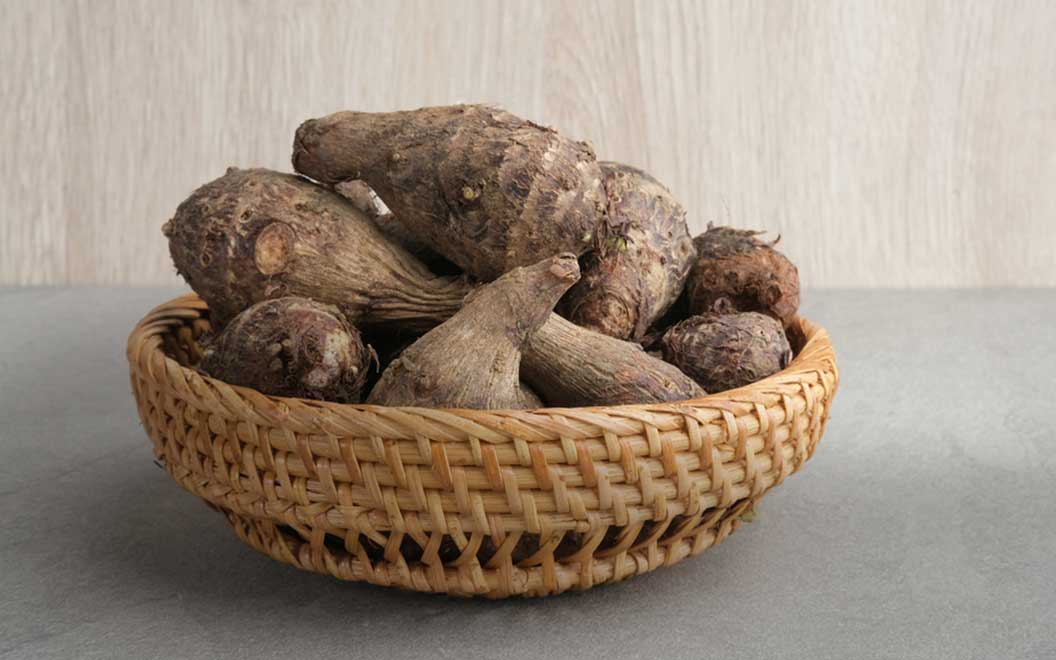The term Cocoyam refers to a variety of tropical root and vegetable crops of the Arum family (also known as Aroids and by the family name Araceae). Cocoyams are herbaceous perennial plants of the Araceae family that are farmed largely for their delicious roots; however, they are edible in all sections of the plant. Cocoyams grown for food belong to the genera Colocasia and Xanthosoma, and are typically made up of a huge spherical corm (swollen subterranean storage stem) from which a few large leaves emerge.
The nutritional value of cocoyam is said to be superior to that of other root and tuber crops, particularly in terms of protein digestibility and mineral composition. Nigeria is known to be the world’s biggest producer of cocoyam, producing 5.49 million metric tons per year, accounting for 45.9% of worldwide output and 72.2 percent of West African output.
ORIGIN
Cocoyam is said to have originated in tropical America, most likely Central and South America, where the plant was domesticated from the wild. They are considered invasive in several parts of the world (French Polynesia, Florida, the Galåpagos Islands, Puerto Rico, and Costa Rica), as well as having been deliberately introduced to Africa and Asia. Because there is no documented time of introduction, it is a more recent introduction to Ghana and West Africa than the other important genus, Colocassia, which is considered to be endemic to the sub region.
In West Africa, coco-yam is known regarded as “new cocoyam.” Brown (2000) dated its arrival in West Africa to the 16th and 17th centuries, whereas Wright (1930) recorded the West Indian Missionaries bringing it to Ghana in 1843 (19th century): there is a scarcity of material on the species in the region between the 17th and 19th centuries.
CULTIVATION
It’s really simple to grow. Cocoyam grows well on well-drained loamy soil and may be planted as soon as there is a steady stream of rain. When planted in fertile soil with a high-water retention capacity, it provides the highest yields. Most cocoyam cultivars need around eight months to develop after being planted. It comes in two major colors: white and pink, and may be planted one meter apart in a row on the crests of piles or hills.
IMPORTANCE
It contains more protein, vitamin, and mineral content than other root and tuber crops, such as cassava and yam, according to experts. Cocoyam is a flexible staple that may be used as a weaning meal and the leaves can be prepared as a vegetable.
Cocoyam, like other roots and tubers, supplies carbohydrate-based nutritional energy. It has more carbohydrate than potatoes, at 112 calories per 100 g. Like other root crop proteins, it has a low protein concentration of 1-2 percent, which implies sulfur-containing amino acids are scarce. Cocoyams have a greater protein and amino acid content than many other roots and tubers, despite their high carbohydrate content. The protein content of cocoyam is higher (1.12 percent for taro and 1.55 percent for tannia) when compared to other tropical root crops.
Cocoyam, on the other hand, is gluten-free and has a high-quality phytonutrient profile that includes dietary fiber, antioxidants, and a modest amount of minerals and vitamins. Cocoyam also contains important B-complex vitamins such as pyridoxine (vitamin B6), folate, riboflavin, pantothenic acid, and thiamine. Zinc, magnesium, copper, iron, and manganese are among the minerals found in the corms.
USES
Cocoyam tubers may be utilized in the same way as other root and tuber crops (such as yam, potato, and cassava), and they can be transformed into various products and used in the industrial sector. Boiling, roasting, baking, frying in oil, pasting, milling, and crushing are some of the methods for turning cocoyam into a shelf-stable food and adding value to it. Pasta made from a combination of wheat and taro flours has also been proposed. Ghanaian fufu, a pounded
version of boiling cocoyam, is a popular example. Soup thickeners and baking flours, drinks, cereal, and meals for persons with gastrointestinal problems are among the other applications.
CONCLUSION
Cocoyam is an important food security crop for many people in many tropical locations, especially smallholder farmers. Cocoyam is one of the world’s sixth most significant root and tuber crops, according to the Food and Agriculture Organization. It’s prevalent in Africa, the Caribbean, South America, and Southeast Asia.


Comments are closed.